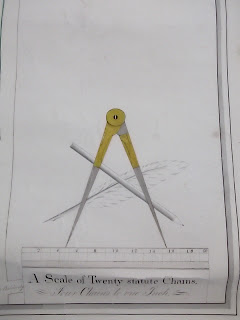Following my earlier blog on ‘speech, manuscript
and print’, http://c18thgirl.blogspot.co.uk/2013/11/early-modern-common-law-scholarship.html, I
pondered on the relationship between speech and written text, and the
importance of the quill pen in times preceding the typewriter and computer
keyboard.
A number of years ago, while working on the MH12
(Manchester Workhouse) project at The National Archives (TNA), I was sitting
alongside Malcolm Mercer, their medieval specialist at the time, who was
looking at 14th century rolls of the Coram Rege: in particular,
KB 27/168/1, November 1301 - November 1302. About half way through the roll a
quill pen was found twisted into the cord of the spine. The ink on the nib was
a black as it would have been on the day it was left, having been protected
against exposure to sunlight for 600 years. What was more important, the roll
or the pen? The answer must be both: material artifacts such as the quill pen
tell their own story: one can imagine the scribe going to work the following
day, sitting at his desk, scratching his head and wondering where on earth he
had left his pen. Likewise, Dr Susanne Jenks found a quill pen in a 1620 plea roll (CP 40/2068 part 2), an image of which can be found on the TNA website.
Quill pens were the principal writing instrument
in the Western World from the 6th to the 19th century. Quill pens were most commonly made from goose
or swan feathers during the medieval period because of their compatibility with
parchment and vellum: some say that the feathers of the Lincolnshire goose are the best.
If you enter ‘pen’ AND quill’ into The National Archive
catalogue you get 55 results, which include quill pens left with a related
document, wills left by pen and quill manufacturers and dealers, the image of
quill pens to decorate tithe maps, and photographs of individuals holding a
quill pen. Additional references for quill pens in TNA records can be found by
a general search of the home page for ‘quill pen’.
 COPY
1/460/547 - 'Photograph of oil painting by Gabriel Metsu entitled 'The Little
Writer Surprised' (c. 1662): Young girl writing with quill pen at a table with
a young man looking over her shoulder.
COPY
1/460/547 - 'Photograph of oil painting by Gabriel Metsu entitled 'The Little
Writer Surprised' (c. 1662): Young girl writing with quill pen at a table with
a young man looking over her shoulder.E 192/15/5 - Bills and receipts for the Countess of Warwick and Holland (many for Walter Mortimer on her behalf), 12 May 1684:
For the a/c of my Lord
For a book called Quintus Curtius 00 03 00
Latin Grammar 00 01 06
For Quills 00 01 06
For paper 00 01 00
For Ink 00 00 06
In all 00 07 06
I received in full the sume of 7s 6d
I Disecote
In 1823, the Encyclopaedia Britannica offered the following helpful instructions for preparing a quill:
“In order to harden a quill that is soft,
thrust the barrel into hot ashes, stirring it till it is soft; then taking it
out, press it almost flat upon your knees with the back of a penknife, and
afterwards reduce it to a roundness with your fingers."
 IR 30/42/252- Tithe map of Middleton Quernhow (township in the parish
of Wath), North Riding of Yorkshire. Decorative border: dividers, quill pen and pencil
surmount the scale bar. (1838)
IR 30/42/252- Tithe map of Middleton Quernhow (township in the parish
of Wath), North Riding of Yorkshire. Decorative border: dividers, quill pen and pencil
surmount the scale bar. (1838)
Metallic pens and pen nibs were introduced
in the mid-19th century (although a bronze pen was found in the ruins of
Pompeii). John Mitchell of Birmingham is credited with
having introduced the machine-made steel pen point in 1828. http://www.britannica.com/EBchecked/topic/449539/pen#ref290261
BT 51/5/8613 - Class 1: metal goods.
Registered design No 8613: registered by C Brandauer and Company, Steel Pen and
Pen Holder Manufacturer, of New John Street West, Birmingham. Metallic tip of penholder. The novelty is the
shape of the internal tube which admits of an ordinary pen or a crow quill or
mapping pen being held in the same holder. (18 June, 1884)
A physical representation of the design can be found in BT 50/12.
A visual history of the quill pen, produced
by the Museum of Writing, can be found on YouTube at http://www.youtube.com/watch?v=36h1vt-9sss






No comments:
Post a Comment